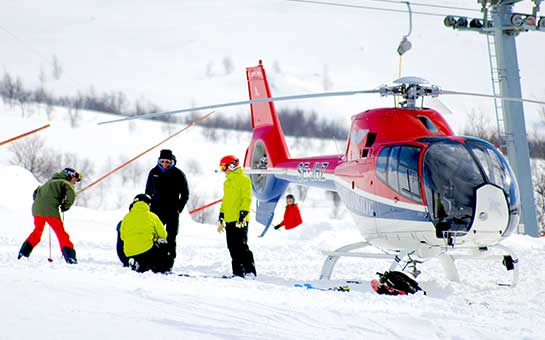Imagine yourself staring at a white blanket of snow and blue sky as far as you can see. It’s beautiful and quiet, just you alone with your thoughts. If you’re lucky, the snow isn’t marred by tracks from someone else. Your heart begins to race from the thrill of what’s to come your way, then you start gliding down the mountain.
For adventurists, heli-skiing is an experience that will keep you wanting more. The thrill of heli-skiing is undeniable, yet the aspect of risk remains. This is why it is important to protect yourself with travel insurance for heli-skiing.
Travel Insurance for Heli-Skiing
Getting travel Insurance for heli-skiing will ensure coverage for treatment on the monetary aspect of an injury. This is important because then you can focus on recovery. Regular travel insurance plans do not offer coverage for heli-skiing as it is an extreme sport, what you need is an adventure sports insurance plan that specifically covers heli-skiing. Such a plan will ensure that when you do travel you can enjoy heli-skiing knowing that you are secured with an insurance plan that will cover your activities.
You should ensure that the plan you’re considering has heli-skiing travel insurance coverage. If it doesn’t, you will need to get a plan that does. If you need help choosing a plan, contact our office, we’re happy to direct you to the most suitable heli-skiing insurance plans.
Basics of Heli-Skiing
A common misconception is that daredevil skiers jump out of a hovering helicopter onto the snow below and ski down. Heli-skiing is actually when a helicopter acts as a cable car flying skiers to the best backcountry peaks with miles of untracked snow.
Once atop a peak, skiers with a passion for fresh powder can ski to their heart's content laying claim with their tracks. This type of skiing is not for beginners or the faint of heart, it is dangerous. if it wasn’t dangerous, it wouldn’t be thrilling. This is why heli-skiing is an adventure sport many ski enthusiasts are eager to try at least once.
For skiers wanting to heli-ski, you should already know the basic requirements for skiing, but you need to have the essential technical equipment for backcountry skiing, areas where you’re much farther from help and could only have yourself to depend on when the worst comes. Essential equipment should include:
- Avalanche Transceivers – continuously transmitting signal or beacon, some allow two-way communication
- Snow Shovel – Should be travel friendly, may need to dig yourself or someone else out of snow
- Probe – a pole to find someone buried in an avalanche
- Airbag – if buried in an avalanche, the airbag lets you create a pocket of air so you can breathe
If don’t know how an essential technology piece works or what to do in a dangerous situation, you need to learn before you consider attempting heli-skiing; it’s not a good idea to be desperate and unsure. Heli-skiers need to be self-sufficient, they should be a technically skilled skier, and it’s best if they’re physically fit.
Skiers who have never tried heli-skiing and want to try it should seriously consider their level of expertise. They have to be strong piste skiers and also need to be strong skiers off-piste. They need to be able to ski comfortably on all sorts of terrain. If you know you’re not ready yet, but want to try it someday, try to find classes so you can learn about it and keep skiing, taking coaching when needed.
British Columbia has some of the best powder snow for heli-skiing. It is no wonder that heli-skiing in Canada is so famous. Many skiers have found heli-skiing in Alaska to be a great experience as well. It has been banned in some areas of the world though, so check before you go.
Risks of Heli-Skiing
Fatalities at different locations can vary depending on a specific site’s safety practices, the terrain, and by season as well. You should research to choose locations with a consistently good rating, keeping this in mind as one of the main factors to make your decision.
While narrowing down venues, you should see what you can find out about their pilots because before you can even ski down, you have to get to the top. The pilot of the helicopter should be experienced and have a minimum of 2500 hours flying. A pilot's day typically starts at 6 AM checking the weather and forecasted conditions of the day. If they don’t have a license or don’t meet the basic licensing requirements to fly, you should reconsider getting in the helicopter.
Heli-skiing is an extreme sport and thus comes with the potential of fatal hazards. Since this is backcountry skiing, avalanches are among the most common dangers that you will have to deal with in this sport.
Another danger you must be careful of is tree wells and deep snow immersions. Tree wells are dangerous and can easily lead to suffocation. Getting out of a tree well is next to impossible if you’re alone. Unmarked cliff ends can also be a serious risk.
On top of all of these risks, there is still the potential for minor and major musculoskeletal injuries. If you break your leg miles from help and in inhospitable conditions, your emergency transceiver can get the help to you, but you’ll have to be taken out either by snowmobile or helicopter – this is what’s called a rescue; it isn’t cheap and without the right insurance plan, you’ll be paying from your own bank account.
Due to these risks, it is important that you get heli-skiing travel insurance. Such extreme sports travel insurance can ensure financial security for unexpected accidents.
